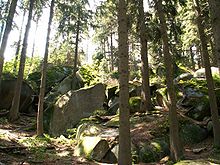Kosseine granite


Köseine granite , also known as Kleinwendern granite or Schurbach granite , is a granite rock that is quarried near the mountain range Köseine near Schurbach and Kleinwendern in the Fichtelgebirge in Upper Franconia (Bavaria). Blue granites are very rare. The Kosseine granite is the only blue to blue-gray granite that is currently being quarried in Europe. It is a biotite muscovite granite (hence also two mica granite), from the upper carbon . A yellowish type of Köseine occurs in small-winners.
Occurrence
The deposit is located at the Luisenburg rock labyrinth at the southern foot of the 939 meter high Kosseine elevation , in a narrow band that stretches to the east. Only the eastern parts of the lower rock labyrinth consist of Kosseine granite and the western parts of roof granite . The granite used to be extracted in eight quarries in the south of the Fichtelgebirge near Luisenburg and Neusorg , today there is only one quarry in Waldershof in the Tirschenreuth district . The largest Kosseine quarry was in Kleinwendern and in the 1980s there were four quarries in operation.
Before 1945, the so-called Wolfsgarten granite, which was blue-yellow in color, was mined on the western slope of the Kornberg in the Fichtelgebirge. This was originally called Köseine granite and today's Kosseine granite was called Kleinwendern granite. Already before 1930 the quarry at Kornberg was used only a little and after 1945 it was completely closed, after that the trade name Kosseine granite for the blue granites of the Kosseine deposit prevailed.
Rock description

The blue coloration in the Kosseine granite comes from cordierite deposits in the microcline feldspars. According to Grimm, it is a "unique rock" because an "assimilation of neighboring rock causes the blue color" . There are some types of granite in Europe that have the word “blue” in their trade names ( Bavarian blue , Bleu des Vosges , Blue Keltic , etc.) but they are not blue granites, but rocks that have a gray-blue ins Have light blue trending color.
Kosseine granite is a coarse-grained granite with feldspars , these are the blue microcline and isolated whitish-yellow and light olive plagioclase, translucent quartz and black biotite (dark mica). Its texture is grainy and the feldspars form a porphyry structure; the arrangement of the minerals is randomly granular. This granite can be lightened by intensive and long-term exposure to sunlight. It is weatherproof.
Mineral inventory and use
Kßeine granite contains 41 percent alkali feldspar , 36 percent quartz , 13 percent plagioclase , 6 percent biotite (dark mica), and 2 percent muscovite (light mica). Small admixtures, which are called petrographic accessories , are the minerals tourmaline , apatite , rutile and opaque (opaque) ore. Its mineral grain size is between 3 and 5 millimeters and some alkali feldspars are 15 to 20 millimeters in size. Like the Fichtelgebirgsgranite, Kosseine granite is a so-called two-mica granite with the mica minerals biotite and muscovite.
The granite rock has almost no pore space and, like granite, is generally frost-resistant. Kosseine granite is suitable for monumental buildings for columns and window and door frames, stair and floor coverings, facade slabs and monuments.
Kosseine granite was used at the main train station and the Moses fountain, the Palace of Justice and at the entrance to the Technical University in Munich , Dresdner Bank in Frankfurt am Main , the stock exchange in Zurich and on the building of the Montan-Union in Luxembourg .
literature
- W. Dienemann and O. Burre: The usable rocks of Germany and their deposits with the exception of coal, ores and salts , Enke-Verlag, Stuttgart 1929, p. 20ff
- Karlfriedrich Fuchs: stone index: natural stones from all over the world; discover, determine, apply. Callwey-Verlag, Munich 1997, sheet 49.
- Wolf-Dieter Grimm: picture atlas of important memorial stones of the Federal Republic of Germany , ed. from the Bavarian State Office for Monument Preservation, Lipp-Verlag, Munich 1990, Gesteins No. 005.
- Uwe Kraeft: Granite from the Fichtelgebirge , STEIN magazine 3/91, Callwey Verlag, Munich.
- Friedrich Müller : Bavaria's rich corner. Geological history. Rocks. Minerals. Fossils from the Fichtelgebirge, Franconian Forest, Münchberg Masse and northern Upper Palatinate Forest , 2nd edition, Ackermann-Verlag, Hof 1990.
- Friedrich Müller (Ed.): INSK - The international natural stone index for the current market. 10 vol., Ebner-Verlag, Ulm 2006, sheet 2.5.1 and 2.5.2
See also
Web links
Individual evidence
- ↑ Kickeine, yellowish variation from the building material collection of the Faculty of Architecture at the Technical University of Munich ( Memento of the original from July 19, 2007 in the Internet Archive ) Info: The archive link was inserted automatically and has not yet been checked. Please check the original and archive link according to the instructions and then remove this notice.
- ↑ Müller: INSK, sheet 2.5.2 (see literature)
- ↑ Grimm: Bildatlas, Gesteins No. 005 (see literature)
- ↑ Fuchs: Steinkartei, p. 49 (see literature)
- ↑ Grimm, Bildatlas, rock no. 005 (see literature)


